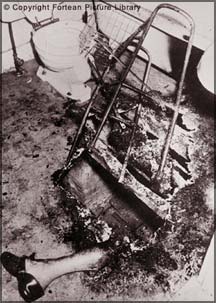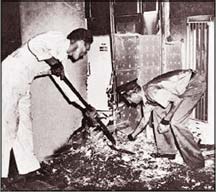|
observer |
|
|
|
|
|
OTHER LINKS |

|

|

|
Spontaneous Human Combustion
The mystery surrounding SHC came about from the way the bodies seem to burn, with intense heat, reducing the body to a pile of ashes. In reality this would normally be hard to achieve, the heat source needed to burn bone to ash being of temperatures not normally reached in a normal house fire. However, tests recently done by scientists on the corpse of a pig, have proved that the human candle effect (or in this case a pig) does happen. Here are a few case studies in to the phenomena: John Irving Bentley This is probably one of the most well documented cases of SHC. On December 1966, Friends had said goodbye to a 92 year old man named Dr. John Irving Bentley. The time they said was around 9.00pm. The next morning a meter reader, who had been allowed to enter the house on his own due to Dr. Bentley's poor physical state, had let himself in to the basement of the house to read the meter. On entering the house, he noticed a foul smell. he also claimed he had seen a strange blue smoke. Worried by this, he made his way in to Dr. Bentleys bedroom, which he discovered was full of smoke. It wasn't until he entered the bathroom that he discovered the charred remains of the doctor. All that remained of him was the lower half of his right leg, still wearing a slipper. The bath which was next to the body had been virtually untouched by the fire, and the rest of the bathroom was unaffected, apart from staining from the smoke. the coroner recorded his death, and stated that he had suffered 90% burns to his body. Mrs. Reeser Another fascinating case of SHC, is that of Mrs. Reeser. The 67 year old widower was discovered on the morning of July 2nd 1951 by painters who were decorating her house. When she was discovered, her body was still smouldering from the intense heat that had obviously been generated. All that remained of her was a burnt-out corpse. Her left foot however, remained almost untouched, and as with the first case above, it still had a slipper on. According to those who examined her, the heat generated was so intense, her skull had been shrunk to the size of a small ball, and her liver was found to be fused to her spine. The surrounding area was almost untouched by the fire. A greasy substance was found to be coating the walls of the room, and a light switch had been melted, but apart from this, the only area area affected was a small circle around the body of Mrs. Reeser. Experts say that the temperature needed to cause this kind of scenario would be in the region of 2,500 degrees. Robert Francis Bailey Early in the morning of 13 September 1967, some people walking to work in Lambeth, South London, noticed a bright light inside a derelict house at 49 Auckland Street. At 5:19 AM, one of them telephoned the emergency services. At 5:24, the Lambeth Fire Brigade arrived with Brigade Commander John Stacey. The crew entered the building and discovered the bright light was the burning body of a local alcoholic, Robert Bailey, who had sought shelter in the abandoned house overnight. Strangely, though, neither the fabric of the house itself, nor its internal fittings was damaged. The only thing on fire was Bailey himself. "When we entered the building," said Stacey, "he was lying on the bottom of the stairs half-turned onto his left side and his knees were drawn up as though he was trying to bend the pain from his stomach." Stacey said, 'There was about a four inch slit in his stomach and the flame was emanating from that four-inch slit like a blow-torch. It was a blue flame.' Thinking the man might possibly still be alive, Stacey and his men emptied several fire extinguishers over the body, putting out the flame but with difficulty. The flame was actually coming from the body itself, said Stacey, "from inside the body. He was burning literally from the inside out. And it was definitely under pressure. And it was impinging on the timber flooring below the body, so much so that the heat from the flame was charred into the woodwork." One especially bizarre feature of the case was that Bailey, while still alive and apparently convulsed in agony, had bitten deeply into the solid mahogany newel post of the stairs. His body remained with its teeth locked into the wood and had to be prised open by the firemen. Bailey's clothing was undamaged except in the area of his abdomen. The area around him was largely undamaged except for the wooden planking immediately under his abdomen where a hole had been burnt. Combustible material only inches away was unburnt. An inquest sat under coroner Dr Gavin Thurston, who initially wished to list the death as "asphyxia due to inhalation of fire fumes". However a second hearing found that Bailey's death was due to "unknown causes". Subsequent investigation by fire and police disclosed no source of ignition. The mains supply of gas and electricity had been cut off in the house and no matches were found. Even if the unfortunate Bailey had fallen asleep and dropped a cigarette on himself, the kind of burning seen at first hand and extinguished by the fireman on the scene cannot be accounted for by the 'wick effect'. It was a rapid, acute burning episode, highly localised in the victim's abdomen, producing a flame 'like a blow torch' that an experienced professional fire fighter found difficult to extinguish immediately. Importantly, too, the firemen were on the scene within 5 minutes of being called, and the body they found had no fire damage apart from the small area in the abdomen, showing that it had only recently begun to burn. The flame was a "bright" blue flame -- bright enough to attract the attention of passers-by in the street. This, too, is not characteristic of a 'wick-effect' fire. The Theories The physical possibilities of spontaneous human combustion are remote. Not only is the body mostly water, but aside from fat tissue and methane gas, there isn't much that burns readily in a human body. To cremate a human body requires enormous amounts of heat over a long period of time. To get a chemical reaction in a human body which would lead to ignition would require some doing. If the deceased had recently eaten an enormous amount of hay that was infested with bacteria, enough heat might be generated to ignite the hay, but not much besides the gut and intestines would probably burn. Or, if the deceased had been eating the newspaper and drunk some oil, and was left to rot for a couple of weeks in a well-heated room, his gut might ignite. It is true that the ignition point of human fat is low, but to get the fire going would probably require an external source. Once ignited, however, some researchers think that a "wick effect" from the body's fat would burn hot enough in certain places to destroy even bones. To prove that a human being might burn like a candle, Dr. John de Haan of the California Criminalistic Institute wrapped a dead pig in a blanket, poured a small amount of gasoline on the blanket, and ignited it. Even the bones were destroyed after five hours of continuous burning. The fat content of a pig is very similar to the fat content of a human being. The damage to the pig, according to Dr. De Haan "is exactly the same as that from supposed spontaneous human combustion." The scientists believe they demonstrated how a case of spontaneous human combustion can occur through normal processes on a person who has been knocked unconscious. The wick effect means that a person could burn slowly without attracting attention from passers-by. It also explains why only part of the body, the part which is rich in fat, burns while the rest stays intact. Possible Conclusions Here a a few findings as published by the Skeptical Enquirer. In most cases combustion probably wasn't spontaneous. Candlesticks, oil lamps, pipes, and the like were often found near the victims. Mrs. Reeser when last seen alive was smoking a cigarette. The victims tended to be slow to react. Many were alcoholics; others were elderly, overweight, or handicapped in some way. Mrs. Reeser was 67, weighed 175 pounds, and had a bad leg. The evening before her demise she told her son she had taken two sleeping pills and expected to take two more. Bodies can be totally consumed at temperatures much lower than previously believed. Proponents of paranormal explanations for SHC often point out that crematoriums use temperatures of 2,000 degrees or more, much hotter than the usual household fire. But experts say high temps are necessary only if the body must be destroyed in a short time. Smoldering fires can consume an entire piece of furniture (and presumably the body within it) if given long enough. Yet they often leave nearby objects undamaged. Twelve hours passed between the time Mrs. Reeser was last seen alive and the time her remains were discovered. In cases where the body was completely destroyed, there was often a nearby source of combustible material to feed the fire. The floorboards beneath a number of victims were found burnt through; Mrs. Reeser was wearing a flammable nightgown and housecoat and was sitting in an overstuffed chair. In addition--this gets pretty gross--the fuel sources may have served to catch melting body fat which then added to the flames. Call it the "candle effect." A quantity of "grease," Nickell and Fischer note, was found where Mrs. Reeser's chair had stood. |









